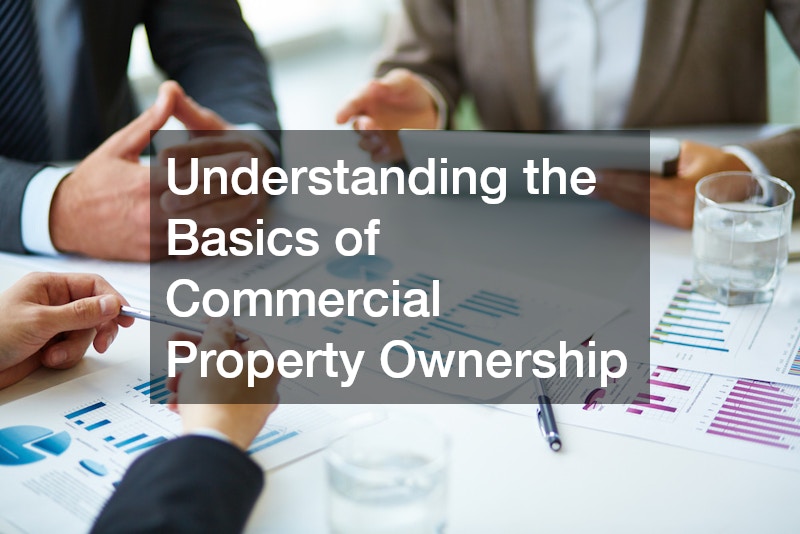
Owning commercial real estate can be one of the most rewarding ventures in the business world. The opportunities for steady income, appreciation, and long-term wealth are immense—but so are the responsibilities. Understanding the intricacies of commercial property ownership can make the difference between a thriving investment and an expensive learning experience.
Whether you’re a first-time investor or a seasoned property owner, mastering the fundamentals of managing, maintaining, and maximizing your commercial property will ensure lasting success.

Understanding the Basics of Commercial Property Ownership
What Defines a Commercial Property
Commercial properties include office buildings, retail centers, industrial spaces, and mixed-use developments. Unlike residential real estate, these spaces are designed primarily for business operations and income generation. Successful commercial property ownership requires a deep understanding of local markets, zoning laws, and tenant expectations.
Investors typically choose between two approaches: owner-occupied properties, where the investor’s business operates within the space, and investment-only properties, where tenants lease the units for business use. Each model comes with unique benefits, tax implications, and maintenance demands.
Why Investors Are Drawn to Commercial Real Estate
Commercial properties often provide higher income potential than residential investments. Leases tend to be longer, reducing tenant turnover, and expenses can be shared with tenants under net lease structures. Moreover, commercial property ownership allows investors to build equity while benefiting from predictable cash flow.
It’s also a hedge against inflation—rental income and property values typically rise with economic growth. For those seeking diversification, owning commercial real estate offers tangible assets that perform independently of the stock market.
Evaluating Potential Commercial Investments
Conducting Market Research
Before purchasing, a wise investor performs detailed market analysis. Understanding supply and demand, vacancy rates, and nearby developments can significantly impact returns. An area with strong employment growth and business expansion is ideal for long-term stability.
A key aspect of commercial property ownership is evaluating demographic trends. For instance, proximity to major transportation routes, hospitals, or universities can attract reliable tenants and support consistent occupancy rates.
Understanding Property Valuation
Proper valuation ensures you don’t overpay or underestimate future profits. Metrics like capitalization rate (cap rate), net operating income (NOI), and cash-on-cash return help gauge investment performance.
For example, the cap rate divides annual net income by the purchase price, giving investors a snapshot of expected yield. A trusted appraiser or real estate analyst can provide an unbiased property valuation that aligns with your goals for commercial property ownership.
Performing Due Diligence
Due diligence is non-negotiable. This process includes property inspections, lease audits, environmental assessments, and financial reviews. Experienced investors often collaborate with legal and accounting professionals to verify zoning compliance, tenant histories, and title integrity.
A thorough approach to commercial property ownership ensures you uncover hidden risks before finalizing a deal, saving both time and money.

Financing and Budgeting for Commercial Property
Exploring Financing Options
Funding a commercial property differs from residential loans. Lenders focus heavily on the property’s income potential rather than the borrower’s personal credit. Options include conventional bank loans, SBA 504 loans, bridge financing, and private equity partnerships.
Investors engaged in commercial property ownership should also consider loan-to-value ratios, interest rates, and amortization schedules to structure financing effectively. Working with lenders who specialize in commercial real estate can streamline the process and secure favorable terms.
Creating a Realistic Budget
Your budget should account for purchase costs, maintenance, taxes, insurance, and improvements. Unexpected expenses are common, so maintaining a contingency fund is crucial. Engaging a qualified contractor or engineer helps forecast capital improvement costs accurately.
Partnering with professionals for upgrades—such as commercial roof repair or interior redesigns—protects the property’s integrity and sustains long-term value. Meticulous financial planning is the foundation of responsible commercial property ownership.
Managing Long-Term Cash Flow
Cash flow determines whether your investment succeeds or struggles. Analyzing rental income, occupancy rates, and operational expenses is essential. Regular rent reviews ensure your property remains competitive in the market.
Effective commercial property ownership also involves timing lease renewals strategically to minimize vacancies. Having a clear maintenance plan keeps costs predictable while preserving tenant satisfaction.
Managing and Maintaining Commercial Properties
Prioritizing Preventative Maintenance
Preventative maintenance prevents minor issues from becoming costly disasters. Routine checks of HVAC systems, roofing, plumbing, and safety equipment preserve both functionality and aesthetics.
Building a trusted network of specialists—including commercial plumbers and electricians—ensures repairs are handled swiftly. A proactive approach to commercial property ownership safeguards your reputation and helps maintain consistent tenant occupancy.
Enhancing Value Through Renovations
Regular renovations not only attract new tenants but also command higher rental rates. Modern amenities, efficient layouts, and aesthetic updates make properties more competitive. Collaborating with contractors for painting, flooring, and lighting upgrades can dramatically enhance appeal.
Working with a local commercial electrician is essential when installing updated lighting systems, electrical panels, or security features. By investing in improvements, you’re strengthening the long-term viability of your commercial property ownership.
Ensuring Safety and Accessibility
Safety compliance isn’t optional—it’s a legal and ethical obligation. Regular inspections by certified professionals, such as commercial fire alarm installers, guarantee your property meets fire code standards. Accessibility features, like ramps and elevators, support inclusivity and widen your potential tenant pool.
The best commercial property ownership strategies integrate both safety and accessibility into daily operations, protecting tenants, visitors, and the property’s long-term reputation.

Tenant Relations and Lease Management
Selecting the Right Tenants
Successful commercial property ownership depends on finding reliable tenants. A strong tenant mix enhances property synergy and reduces vacancy risk. Screening applicants for financial stability, business credibility, and alignment with property goals helps ensure consistent performance.
A diverse tenant base—such as retailers, professional offices, or healthcare providers—minimizes dependency on one industry and increases resilience against market fluctuations.
Crafting Effective Lease Agreements
Leases define the relationship between owner and tenant. They should outline rent structures, maintenance obligations, and renewal options. Having an attorney review lease terms helps prevent future disputes.
Transparent communication from the start fosters mutual trust. In commercial property ownership, clarity on responsibilities and costs ensures smooth operations and predictable income.
Building Long-Term Relationships
Tenant retention saves time and money. Responsive management, prompt repairs, and strong communication keep tenants satisfied. Small gestures—like timely upgrades or personalized services—go a long way in promoting loyalty.
Partnering with reliable vendors such as commercial cleaning companies helps maintain a professional, appealing environment that encourages tenants to renew their leases. Consistency in care reflects the professionalism of your commercial property ownership strategy.
Risk Management and Compliance
Meeting Legal and Regulatory Standards
Legal compliance protects investors from lawsuits and penalties. Adhering to zoning regulations, fire codes, and environmental laws is non-negotiable. Regular audits and documentation keep operations transparent.
Reliable commercial property ownership also means maintaining insurance coverage against liability, loss of income, and structural damage. Adequate coverage ensures business continuity in the face of unexpected events.
Managing Environmental and Structural Risks
Proactive risk management includes addressing environmental hazards, water intrusion, and pest infestations before they escalate. Scheduling periodic commercial pest control services is an effective way to maintain hygiene and tenant satisfaction.
Staying proactive reflects strong commercial property ownership values—it shows commitment to safety, cleanliness, and professionalism.
Preparing for Market Fluctuations
Economic shifts can affect rental demand, financing, and property values. Keeping a reserve fund and maintaining flexible leasing structures can soften downturns.
Diversifying your property portfolio also stabilizes income streams. Forward-thinking commercial property ownership involves staying adaptable and responsive to market cycles.

Working With Professionals and Building a Support Network
Building a Strong Professional Team
No investor succeeds alone. Surrounding yourself with experienced professionals ensures operational efficiency. Property managers, accountants, and legal advisors handle daily challenges and strategic planning.
Specialized vendors also play a crucial role. Commercial HVAC service providers maintain climate control systems essential for tenant comfort. Partnering with trusted experts is one of the smartest moves in sustainable commercial property ownership.
Leveraging Technology for Smarter Management
Modern property owners benefit from digital management tools that streamline communication, maintenance scheduling, and rent collection. Smart building systems improve energy efficiency and track occupancy patterns.
Integrating commercial video surveillance systems enhances security while providing real-time monitoring capabilities. Technology-driven commercial property ownership gives investors peace of mind and helps reduce long-term costs.
Maintenance, Aesthetics, and Tenant Experience
Maintaining Exterior Appeal
Curb appeal isn’t just for homes—it matters for commercial spaces too. Clean exteriors, clear signage, and well-maintained parking areas signal professionalism. Partnering with commercial paving services helps create safe, visually appealing parking lots and pathways.
Landscaping and exterior lighting also influence first impressions. Thoughtful maintenance practices are essential to the overall success of commercial property ownership.
Improving Interior Comfort and Efficiency
Comfortable work environments attract tenants and boost productivity. Improvements like insulation, natural lighting, and aesthetic finishes contribute to long-term satisfaction.
For added comfort and energy savings, a commercial window tinting service can help regulate indoor temperatures and reduce glare. Enhancing interior spaces demonstrates commitment to both form and function within your commercial property ownership plan.
Expanding Functionality With Upgrades
Every upgrade should serve a purpose. Installing advanced HVAC systems, renewable energy solutions, or additional amenities can make your property more appealing to premium tenants.
Reliable utility providers, including commercial plumbers, ensure building systems run efficiently. Functional upgrades show tenants that your commercial property ownership approach is forward-thinking and responsive.
Enhancing Property Value Through Renovations
The Role of Renovations in Long-Term Growth
Periodic renovations keep properties competitive and align them with evolving market trends. Updating lobbies, restrooms, and outdoor areas improves tenant satisfaction and increases market value.
Working with trusted contractors to manage these projects ensures compliance and quality craftsmanship. This kind of proactive investment distinguishes effective commercial property ownership from reactive management.
Maintaining Safety and Infrastructure
Safety upgrades protect both property and people. Installing reliable security lighting, structural reinforcements, and updated wiring systems minimizes risks. Partnering with reputable commercial fire alarm installers further strengthens building safety and compliance.
Integrating these systems demonstrates a commitment to excellence, a hallmark of responsible commercial property ownership.
Ongoing Maintenance Planning
Consistent inspections and repairs keep operations seamless. Establishing annual maintenance schedules helps prevent budget surprises and reduces downtime.
Collaborating with property managers and service providers ensures all areas—from plumbing to landscaping—receive timely attention. Thorough commercial property ownership depends on structured maintenance as much as on design and development.
Maximizing Return on Investment
Increasing Income Potential
Revenue growth begins with understanding your tenants’ needs. Offering amenities like shared conference rooms, high-speed internet, or on-site cafés attracts premium businesses willing to pay higher rent.
Commercial property ownership also benefits from creative leasing strategies—tiered pricing, flexible lease terms, or shared-space arrangements that cater to small and large businesses alike.
Reducing Operational Costs
Efficiency equals profitability. Upgrading insulation, automating lighting systems, and performing regular HVAC tune-ups reduce energy consumption and lower expenses. Collaborating with reliable commercial HVAC service teams keeps systems running efficiently year-round.
Every dollar saved on operations adds value to your investment and enhances the financial health of your commercial property ownership portfolio.
Long-Term Exit Strategies
A successful investor always plans the exit before entering. Whether you intend to hold, refinance, or sell, the key is timing and market awareness.
Comprehensive records, regular appraisals, and transparent accounting improve your property’s resale potential. When managed wisely, commercial property ownership becomes a cornerstone of lasting wealth and generational success.
Commercial real estate offers immense rewards—but it demands knowledge, dedication, and strategic planning. Successful commercial property ownership is about more than collecting rent; it’s about building relationships, ensuring safety, and enhancing value over time.
Investors who commit to maintenance, compliance, and continuous improvement position themselves for long-term prosperity. From scheduling commercial pest control services to coordinating upgrades with trusted vendors, every decision shapes your property’s legacy.
By surrounding yourself with reliable experts—like contractors, inspectors, and financial advisors—you’ll navigate the challenges of commercial property ownership with confidence and precision.
In the end, it’s not just about owning a building. It’s about creating spaces where businesses thrive, communities grow, and investments endure. Strong commercial property ownership also contributes to local economic growth by attracting businesses, creating jobs, and revitalizing communities. Each decision you make—big or small—adds to your property’s legacy, shaping a future built on sustainability, profitability, and trust.


